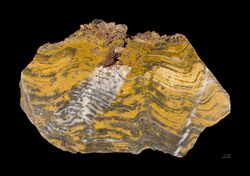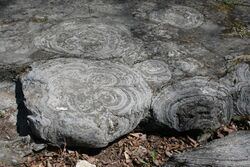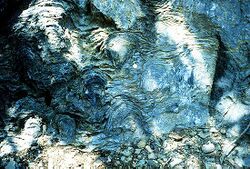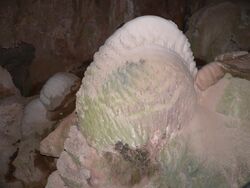Earth:Stromatolite


Stromatolites (/stroʊˈmætəˌlaɪts, strə-/)[2][3] or stromatoliths (from grc στρῶμα (strôma), GEN στρώματος (strṓmatos) 'layer, stratum', and λίθος (líthos) 'rock')[4] are layered sedimentary formations (microbialite) that are created mainly by photosynthetic microorganisms such as cyanobacteria, sulfate-reducing bacteria, and Pseudomonadota (formerly proteobacteria). These microorganisms produce adhesive compounds that cement sand and other rocky materials to form mineral "microbial mats". In turn, these mats build up layer by layer, growing gradually over time.[5][6] A stromatolite may grow to a meter or more.[7][8] Fossilized stromatolites provide important records of some of the most ancient life. As of the Holocene, living forms are rare.
Morphology


Stromatolites are layered, biochemical, accretionary structures formed in shallow water by the trapping, binding and cementation of sedimentary grains in biofilms (specifically microbial mats), through the action of certain microbial lifeforms, especially cyanobacteria.[8] They exhibit a variety of forms and structures, or morphologies, including conical, stratiform, domal, columnar,[9] and branching types.[10] Stromatolites occur widely in the fossil record of the Precambrian, but are rare today.[11] Very few Archean stromatolites contain fossilized microbes, but fossilized microbes are sometimes abundant in Proterozoic stromatolites.[12]
While features of some stromatolites are suggestive of biological activity, others possess features that are more consistent with abiotic (non-biological) precipitation.[13] Finding reliable ways to distinguish between biologically formed and abiotic stromatolites is an active area of research in geology.[14][15] Be it as it may, multiple morphologies of stromatolites may exist in a single local or geological strata, relating to the specific conditions occurring in different region and water depths.[16]
Most stromatolites are spongiostromate in texture, having no recognisable microstructure or cellular remains. A minority are porostromate, having recognisable microstructure; these are mostly unknown from the Precambrian but persist throughout the Palaeozoic and Mesozoic. Since the Eocene, porostromate stromatolites are known only from freshwater settings.[17]
Formation
Time lapse photography of modern microbial mat formation in a laboratory setting gives some revealing clues to the behavior of cyanobacteria in stromatolites. Biddanda et al. (2015) found that cyanobacteria exposed to localized beams of light moved towards the light, or expressed phototaxis, and increased their photosynthetic yield, which is necessary for survival.[18] In a novel experiment, the scientists projected a school logo onto a petri dish containing the organisms, which accreted beneath the lighted region, forming the logo in bacteria.[18] The authors speculate that such motility allows the cyanobacteria to seek light sources to support the colony.[18] In both light and dark conditions, the cyanobacteria form clumps that then expand outwards, with individual members remaining connected to the colony via long tendrils. This may be a protective mechanism that affords evolutionary benefit to the colony in harsh environments where mechanical forces act to tear apart the microbial mats. Thus these sometimes elaborate structures, constructed by microscopic organisms working somewhat in unison, are a means of providing shelter and protection from a harsh environment.
Lichen stromatolites are a proposed mechanism of formation of some kinds of layered rock structure that are formed above water, where rock meets air, by repeated colonization of the rock by endolithic lichens.[19][20]
Fossil record
Some Archean rock formations show macroscopic similarity to modern microbial structures, leading to the inference that these structures represent evidence of ancient life, namely stromatolites. However, others regard these patterns as being due to natural material deposition or some other abiogenic mechanism. Scientists have argued for a biological origin of stromatolites due to the presence of organic globule clusters within the thin layers of the stromatolites, of aragonite nanocrystals (both features of current stromatolites),[14] and of other microstructures in older stromatolites that parallel those in younger stromatolites that show strong indications of biological origin.[21][22]



Stromatolites are a major constituent of the fossil record of the first forms of life on earth.[23] They peaked about 1.25 billion years ago[21] and subsequently declined in abundance and diversity,[24] so that by the start of the Cambrian they had fallen to 20% of their peak. The most widely supported explanation is that stromatolite builders fell victim to grazing creatures (the Cambrian substrate revolution); this theory implies that sufficiently complex organisms were common over 1 billion years ago.[25][26][27] Another hypothesis is that protozoans such as foraminifera were responsible for the decline, favoring formation of thrombolites over stromatolites through microscopic bioturbation.[28]
Proterozoic stromatolite microfossils (preserved by permineralization in silica) include cyanobacteria and possibly some forms of the eukaryote chlorophytes (that is, green algae). One genus of stromatolite very common in the geologic record is Collenia.
The connection between grazer and stromatolite abundance is well documented in the younger Ordovician evolutionary radiation; stromatolite abundance also increased after the end-Ordovician and end-Permian extinctions decimated marine animals, falling back to earlier levels as marine animals recovered.[29] Fluctuations in metazoan population and diversity may not have been the only factor in the reduction in stromatolite abundance. Factors such as the chemistry of the environment may have been responsible for changes.[30][11]
While prokaryotic cyanobacteria reproduce asexually through cell division, they were instrumental in priming the environment for the evolutionary development of more complex eukaryotic organisms.[23] They are thought to be largely responsible for increasing the amount of oxygen in the primeval Earth's atmosphere through their continuing photosynthesis (see Great Oxygenation Event). They use water, carbon dioxide, and sunlight to create their food. A layer of polysaccharides often forms over mats of cyanobacterial cells.[31] In modern microbial mats, debris from the surrounding habitat can become trapped within the polysaccharide layer, which can be cemented together by the calcium carbonate to grow thin laminations of limestone. These laminations can accrete over time, resulting in the banded pattern common to stromatolites. The domal morphology of biological stromatolites is the result of the vertical growth necessary for the continued infiltration of sunlight to the organisms for photosynthesis. Layered spherical growth structures termed oncolites are similar to stromatolites and are also known from the fossil record. Thrombolites are poorly laminated or non-laminated clotted structures formed by cyanobacteria, common in the fossil record and in modern sediments.[14] There is evidence that thrombolites form in preference to stromatolites when foraminifera are part of the biological community.[32]
The Zebra River Canyon area of the Kubis platform in the deeply dissected Zaris Mountains of south western Namibia provides an extremely well exposed example of the thrombolite-stromatolite-metazoan reefs that developed during the Proterozoic period, the stromatolites here being better developed in updip locations under conditions of higher current velocities and greater sediment influx.[33]
Modern occurrence


Saline locations
Modern stromatolites are mostly found in hypersaline lakes and marine lagoons where extreme conditions due to high saline levels prevent animal grazing.[34][35] One such location where excellent modern specimens can be observed is Hamelin Pool Marine Nature Reserve, Shark Bay in Western Australia. Another location is Pampa del Tamarugal National Reserve in Chile. A third is Lagoa Salgada ("Salty Lake"), in the state of Rio Grande do Norte, Brazil , where modern stromatolites can be observed as both bioherms (domal type) and beds. Inland stromatolites can also be found in saline waters in Cuatro Ciénegas Basin, a unique ecosystem in the Mexican desert, and in Lake Alchichica, a maar lake in Mexico's Oriental Basin. The only open marine environment where modern stromatolites are known to prosper is the Exuma Cays in the Bahamas.[36][37]
In 2010, a fifth type of chlorophyll, namely chlorophyll f, was discovered by Min Chen from stromatolites in Shark Bay.[38]
Halococcus hamelinensis, a halophilic archaeon, occurs in living stromatolites in Shark Bay where it is exposed to extreme conditions of UV radiation, salinity and desiccation.[39] H. hamelinesis possesses genes that encode enzymes employed in the repair of UV induced damages in DNA by the processes of nucleotide excision repair and photoreactivation.[39]
In 2023, an area containing stromatolites was discovered in the Puna de Atacama territory of South America, which may be similar to ancient Earth, and the related environment of the first life forms on Earth, and perhaps similar to possibly hospitable conditions long ago on the planet Mars.[40]
Modern freshwater stromatolites

Laguna de Bacalar in Mexico's southern Yucatán Peninsula, in the state of Quintana Roo, has an extensive formation of living giant microbialites (that is, stromatolites or thrombolites). The microbialite bed is over 10 km (6.2 mi) long with a vertical rise of several meters in some areas. These may be the largest sized living freshwater microbialites, or any organism, on Earth.[41]
Alchichica Lake in Puebla, Mexico has two distinct morphologic generations of stromatolites: columnar-dome like structures, rich in aragonite, forming near the shore line, dated back to 1,100 years before present (ybp) and spongy-cauliflower like thrombolytic structures that dominate the lake from top to the bottom, mainly composed of hydromagnesite, huntite, calcite and dated back to 2,800 ybp.[42]
A little farther to the south, a 1.5 km stretch of reef-forming stromatolites (primarily of the genus Scytonema) occurs in Chetumal Bay in Belize, just south of the mouth of the Rio Hondo and the Mexican border.[43]
Large, up to 40 m high, microbialite towers were discovered in the largest soda lake on Earth: 460 m deep Lake Van in Eastern Turkey. They are composed of aragonite growing on presumably precipitating inorganically calcite at sub-lacustrine karst-water sources.[44]
Freshwater stromatolites are found in Lake Salda in southern Turkey. The waters are rich in magnesium and the stromatolite structures are made of hydromagnesite.[45]
Two instances of freshwater stromatolites are also found in Canada , at Pavilion Lake and Kelly Lake in British Columbia. Pavilion Lake has the largest known freshwater stromatolites and NASA is currently conducting xenobiology research there.[46] NASA, the Canadian Space Agency, and numerous universities from around the world are collaborating on a project to study the microbialite life in the lakes. Called the "Pavilion Lake Research Project" (PLRP), its aim is to study what conditions on the lakes' bottoms are most likely to harbor life and develop a better hypothesis on how environmental factors affect microbialite life. The end goal of the project is to better understand what conditions would likely harbor life on other planets.[47] Now concluded, there was a citizen science project conducted online called "MAPPER" where volunteers sorted through thousands of photos of the lake bottoms and tagged the presence of microbialites, algae and other lake bed features.[48]
Microbialites have been discovered in an open pit pond at an abandoned asbestos mine near Clinton Creek, Yukon, Canada.[49] These microbialites are extremely young and presumably began forming soon after the mine closed in 1978. The combination of a low sedimentation rate, high calcification rate, and low microbial growth rate appears to result in the formation of these microbialites. Microbialites at an historic mine site demonstrates that an anthropogenically constructed environment can foster microbial carbonate formation. This has implications for creating artificial environments for building modern microbialites including stromatolites.

A very rare type of non-lake dwelling stromatolite lives in the Nettle Cave at Jenolan Caves, NSW, Australia.[50] The cyanobacteria live on the surface of the limestone, and are sustained by the calcium rich dripping water, which allows them to grow toward the two open ends of the cave which provide light.[51]
Stromatolites composed of calcite have been found in both the Blue Lake in the dormant volcano, Mount Gambier and at least eight cenote lakes including the Little Blue Lake in the Lower South-East of South Australia.[52]
See also
- Banded iron formation
- Cotham Marble
- Gunflint Range
- Laguna Negra, Catamarca
- Microbially induced sedimentary structure
- Ojos de Mar
References
- ↑ Duda, J-P.; Van Kranendonk, M.J.; Thiel, V.; Ionescu, D.; Strauss, H.; Schäfer, N.; Reitner, J. (2016). "A Rare Glimpse of Paleoarchean Life: Geobiology of an Exceptionally Preserved Microbial Mat Facies from the 3.4 Ga Strelley Pool Formation, Western Australia". PLOS One 11 (1): e0147629. doi:10.1371/journal.pone.0147629. PMID 26807732. Bibcode: 2016PLoSO..1147629D.
- ↑ "Stromatolite". Merriam-Webster Dictionary. https://www.merriam-webster.com/dictionary/stromatolite. Retrieved 2016-01-21.
- ↑ "stromatolite". stromatolite. Oxford University Press. http://www.lexico.com/definition/stromatolite.
- ↑ στρῶμα, λίθος. Liddell, Henry George; Scott, Robert; A Greek–English Lexicon at the Perseus Project.
- ↑ Winner, Cherie (November 15, 2013). "What Doomed the Stromatolites?". Woods Hole Oceanographic Institution. https://www.whoi.edu/oceanus/feature/what-doomed-the-stromatolites/.
- ↑ "Two-ton, 500 Million-year-old Fossil Of Stromatolite Discovered In Virginia, U.S.". July 8, 2008. https://www.sciencedaily.com/releases/2008/07/080704122847.htm.
- ↑ "Stromatolites". Indiana University Bloomington. http://www.indiana.edu/~geol105b/images/gaia_chapter_10/stromatolites.htm.
- ↑ 8.0 8.1 Riding, R. (2007). "The term stromatolite: towards an essential definition". Lethaia 32 (4): 321–30. doi:10.1111/j.1502-3931.1999.tb00550.x. http://www3.interscience.wiley.com/journal/119935443/abstract.
- ↑ Zhu, Dongya; Liu, Quanyou; Wang, Jingbin; Ding, Qian; He, Zhiliang (July 2021). "Stable carbon and oxygen isotope data of Late Ediacaran stromatolites from a hypersaline environment in the Tarim Basin (NW China) and their reservoir potential". Facies 67 (3): 25. doi:10.1007/s10347-021-00633-0.
- ↑ Planavsky, Noah; Grey, Kathleen (16 August 2007). "Stromatolite branching in the Neoproterozoic of the Centralian Superbasin, Australia: an investigation into sedimentary and microbial control of stromatolite morphology". Geobiology 6 (1): 070816220552001––. doi:10.1111/j.1472-4669.2007.00116.x. PMID 18380884.
- ↑ 11.0 11.1 Peters, Shanan E.; Husson, Jon M.; Wilcots, Julia (June 2017). "The rise and fall of stromatolites in shallow marine environments". Geology 45 (6): 487–490. doi:10.1130/G38931.1. Bibcode: 2017Geo....45..487P. http://strata.geology.wisc.edu/reprints/Peters_etal2017.pdf.
- ↑ Lepot, Kevin (October 2020). "Signatures of early microbial life from the Archean (4 to 2.5 Ga) eon". Earth-Science Reviews 209: 103296. doi:10.1016/j.earscirev.2020.103296. Bibcode: 2020ESRv..20903296L.
- ↑ Grotzinger, John P.; Rothman, Daniel H. (3 October 1996). "An abiotic model for stromatolite morphogenesis". Nature 383 (6599): 423–425. doi:10.1038/383423a0. Bibcode: 1996Natur.383..423G.
- ↑ 14.0 14.1 14.2 Lepot, Kevin; Karim Benzerara; Gordon E. Brown; Pascal Philippot (2008). "Microbially influenced formation of 2.7 billion-year-old stromatolites". Nature Geoscience 1 (2): 118–21. doi:10.1038/ngeo107. Bibcode: 2008NatGe...1..118L.
- ↑ Perri, E.; Tucker, M. E.; Mawson, M. (25 September 2013). "Biotic and Abiotic Processes In the Formation and Diagenesis of Permian Dolomitic Stromatolites (Zechstein Group, NE England)". Journal of Sedimentary Research 83 (10): 896–914. doi:10.2110/jsr.2013.65. Bibcode: 2013JSedR..83..896P. https://www.researchgate.net/publication/260845254. Retrieved 8 January 2022.
- ↑ Meilijson, Aaron; Bialik, Or M.; Benjamini, Chaim (December 2015). "Stromatolitic biotic systems in the mid-Triassic of Israel — A product of stress on an epicontinental margin". Palaeogeography, Palaeoclimatology, Palaeoecology 440: 696–711. doi:10.1016/j.palaeo.2015.09.030. Bibcode: 2015PPP...440..696M.
- ↑ Monty, C. L. (1981). Monty, Claude. ed. "Spongiostromate vs. Porostromate Stromatolites and Oncolites" (in en). Phanerozoic Stromatolites (Berlin, Heidelberg: Springer): 1–4. doi:10.1007/978-3-642-67913-1_1. ISBN 978-3-642-67913-1. https://link.springer.com/chapter/10.1007/978-3-642-67913-1_1.
- ↑ 18.0 18.1 18.2 Biddanda, Bopaiah A.; McMillan, Adam C.; Long, Stephen A.; Snider, Michael J.; Weinke, Anthony D. (2015-01-01). "Seeking sunlight: rapid phototactic motility of filamentous mat-forming cyanobacteria optimize photosynthesis and enhance carbon burial in Lake Huron's submerged sinkholes". Frontiers in Microbiology 6: 930. doi:10.3389/fmicb.2015.00930. PMID 26441867.
- ↑ Lichen Stromatolites: Criterion for Subaerial Exposure and a Mechanism for the Formation of Laminar Calcretes (Caliche), Colin F. Klappa, Journal of Sedimentary Petrology, Vol. 49 (1979) No. 2. (June), Pages 387–400, [1]
- ↑ Paleobotany: The Biology and Evolution of Fossil Plants, Edith L. Taylor, Thomas N. Taylor, Michael Krings, page [2]
- ↑ 21.0 21.1 Allwood, Abigail; Grotzinger; Knoll; Burch; Anderson; Coleman; Kanik (2009). "Controls on development and diversity of Early Archean stromatolites". Proceedings of the National Academy of Sciences 106 (24): 9548–9555. doi:10.1073/pnas.0903323106. PMID 19515817. Bibcode: 2009PNAS..106.9548A.
- ↑ Cradle of life: the discovery of earth's earliest fossils. Princeton, N.J: Princeton University Press. 1999. pp. 87–89. ISBN 978-0-691-08864-8. https://archive.org/details/cradlelifediscov00scho_554.
- ↑ 23.0 23.1 Garwood, Russell J. (2012). "Patterns in Palaeontology: The first 3 billion years of evolution". Palaeontology Online 2 (11): 1–14. http://www.palaeontologyonline.com/articles/2012/patterns-in-palaeontology-the-first-3-billion-years-of-evolution/. Retrieved 25 June 2015.
- ↑ McMenamin, M. A. S. (1982). "Precambrian conical stromatolites from California and Sonora". Bulletin of the Southern California Paleontological Society 14 (9&10): 103–105.
- ↑ McNamara, K.J. (20 December 1996). "Dating the Origin of Animals". Science 274 (5295): 1993–1997. doi:10.1126/science.274.5295.1993f. Bibcode: 1996Sci...274.1993M.
- ↑ Awramik, S.M. (19 November 1971). "Precambrian columnar stromatolite diversity: Reflection of metazoan appearance". Science 174 (4011): 825–827. doi:10.1126/science.174.4011.825. PMID 17759393. Bibcode: 1971Sci...174..825A.
- ↑ Bengtson, S. (2002). "The fossil record of predation". in Kowalewski, M.. The Paleontological Society Papers. 8. The Paleontological Society. pp. 289–317. http://www.nrm.se/download/18.4e32c81078a8d9249800021552/Bengtson2002predation.pdf. Retrieved 29 December 2014.
- ↑ Bernhard, J. M.; Edgcomb, V. P.; Visscher, P. T.; McIntyre-Wressnig, A.; Summons, R. E.; Bouxsein, M. L.; Louis, L.; Jeglinski, M. (28 May 2013). "Insights into foraminiferal influences on microfabrics of microbialites at Highborne Cay, Bahamas". Proceedings of the National Academy of Sciences 110 (24): 9830–9834. doi:10.1073/pnas.1221721110. PMID 23716649. Bibcode: 2013PNAS..110.9830B.
- ↑ Sheehan, P.M.; Harris, M.T. (2004). "Microbialite resurgence after the Late Ordovician extinction". Nature 430 (6995): 75–78. doi:10.1038/nature02654. PMID 15229600. Bibcode: 2004Natur.430...75S.
- ↑ Riding, R. (March 2006). "Microbial carbonate abundance compared with fluctuations in metazoan diversity over geological time". Sedimentary Geology 185 (3–4): 229–38. doi:10.1016/j.sedgeo.2005.12.015. Bibcode: 2006SedG..185..229R. http://www.robertriding.com/pdf/riding2006mc.pdf. Retrieved 9 December 2011.
- ↑ Kawaguchi, Tomohiro; Decho, Alan W. (January 2000). "Biochemical Characterization of Cyanobacterial Extracellular Polymers (EPS) from Modern Marine Stromatolites (Bahamas)". Preparative Biochemistry and Biotechnology 30 (4): 321–330. doi:10.1080/10826060008544971. PMID 11065277.
- ↑ Nuwer, Rachel (30 May 2013). "What Happened to the Stromatolites, the Most Ancient Visible Lifeforms on Earth?". Smithsonian Magazine. Smithsonian Institution. https://www.smithsonianmag.com/smart-news/what-happened-to-the-stromatolites-the-most-ancient-visible-lifeforms-on-earth-84714880/.
- ↑ Adams, E. W.; Grotzinger, J. P.; Watters, W. A.; Schröder, S.; McCormick, D. S.; Al-Siyabi, H. A. (2005). "Digital characterization of thrombolite-stromatolite reef distribution in a carbonate ramp system (terminal Proterozoic, Nama Group, Namibia)". AAPG Bulletin 89 (10): 1293–1318. doi:10.1306/06160505005. http://www.wellesley.edu/Astronomy/Wwatters/adams%20etal%20-%20digital%20models%20nama%20reefs%20-%20aapg%20bull%202005.pdf. Retrieved 9 December 2011.
- ↑ "Stromatolite | geology". https://www.britannica.com/science/stromatolite.
- ↑ "Oldest evidence of life on Earth found in Australia". The Economic Times. https://economictimes.indiatimes.com/news/science/oldest-evidence-of-life-on-earth-found-in-australia/articleshow/61658155.cms?from=mdr.
- ↑ "217-Stromatolites-Lee-Stocking-Exumas-Bahamas Bahamas". http://sepmstrata.org/Bahamas/pages/217-Stromatolites-Lee-Stocking-Exumas-Bahamas.html.
- ↑ "Stromatolite-thrombolite associations in a modern environment, Lee Stocking Island, Bahamas". PALAIOS 13 (2): 201–212. April 1998. doi:10.2307/3515490. Bibcode: 1998Palai..13..201F.
- ↑ Chen, M. .; Schliep, M. .; Willows, R. D.; Cai, Z. -L.; Neilan, B. A.; Scheer, H. . (2010). "A Red-Shifted Chlorophyll". Science 329 (5997): 1318–1319. doi:10.1126/science.1191127. PMID 20724585. Bibcode: 2010Sci...329.1318C.
- ↑ 39.0 39.1 Leuko S, Neilan BA, Burns BP, Walter MR, Rothschild LJ. Molecular assessment of UVC radiation-induced DNA damage repair in the stromatolitic halophilic archaeon, Halococcus hamelinensis. J Photochem Photobiol B. 2011 Feb 7;102(2):140-5. doi: 10.1016/j.jphotobiol.2010.10.002. Epub 2010 Oct 23. PMID: 21074452
- ↑ Strain, Daniel (6 December 2023). "Deep within an inhospitable desert, a window to first life on Earth". Colorado University. Archived from the original on 30 December 2023. https://archive.today/20231230225404/https://www.colorado.edu/today/2023/12/06/deep-within-inhospitable-desert-window-first-life-earth. Retrieved 30 December 2023.
- ↑ Gischler, E.; Gibson, M.; Oschmann, W. (2008). "Giant Holocene Freshwater Microbialites, Laguna Bacalar, Quintana Roo, Mexico". Sedimentology 55 (5): 1293–1309. doi:10.1111/j.1365-3091.2007.00946.x. Bibcode: 2008Sedim..55.1293G.
- ↑ Kaźmierczak, J.; Kempe, S.; Kremer, B.; López-Garcia, P.; Moreira, D.; Tavera, R. (2011). "Hydrochemistry and microbialites of the alkaline caldera Lake Alchichica, Mexico". Facies 57: 543–570. doi:10.1007/s10347-010-0255-8.
- ↑ Rasmussen, K.A.; Macintyre, I.G.; Prufert, L (March 1993). "Modern stromatolite reefs fringing a brackish coastline, Chetumal Bay, Belize". Geology 21 (3): 199–202. doi:10.1130/0091-7613(1993)021<0199:MSRFAB>2.3.CO;2. Bibcode: 1993Geo....21..199R. http://doc.rero.ch/record/14025/files/PAL_E1070.pdf.
- ↑ Kempe, S.; Kaźmierczak, J.; Landmann, G.; Konuk, T.; Reimer, A.; Lipp, A. (1991). "Largest known microbialites discovered in Lake Van, Turkey". Nature 349 (6310): 605–608. doi:10.1038/349605a0. Bibcode: 1991Natur.349..605K.
- ↑ Braithwaite, C.; Zedef V (November 1996). "Living hydromagnesite stromatolites from Turkey". Sedimentary Geology 106 (3–4): 309. doi:10.1016/S0037-0738(96)00073-5. Bibcode: 1996SedG..106..309B.
- ↑ "Modern Freshwater Microbialites from Kelly Lake, British Columbia, Canada". PALAIOS 12 (3): 213–219. June 1997. doi:10.2307/3515423. Bibcode: 1997Palai..12..213F.
- ↑ Brady, A.; Slater, G.F.; Omelon, C.R.; Southam, G.; Druschel, G.; Andersen, A.; Hawes, I.; Laval, B. et al. (2010). "Photosynthetic isotope biosignatures in laminated micro-stromatolitic and non-laminated nodules associated with modern, freshwater microbialites in Pavilion Lake, B.C". Chemical Geology 274 (1–2): 56–67. doi:10.1016/j.chemgeo.2010.03.016. Bibcode: 2010ChGeo.274...56B.
- ↑ "NASA Help NASA Find Life on Mars With MAPPER". NASA. https://nasa.gov/exploration/analogs/mapper.html.
- ↑ Power, I.M., Wilson, S.A., Dipple, G.M., and Southam, G. (2011) Modern carbonate microbialites from an asbestos open pit pond, Yukon, Canada, http://onlinelibrary.wiley.com/doi/10.1111/gbi.2011.9.issue-2/issuetoc Geobiology. 9: 180–195.
- ↑ Jenolan Caves Reserve Trust. "Nettle Cave Self-guided tour". http://www.jenolancaves.org.au/compulsive_self-guided_cave_tour.php.
- ↑ "Cyanobacterially deposited speleothems: Subaerial stromatolites". Geomicrobiology Journal 7 (4): 245–252. 1989. doi:10.1080/01490458909377870.
- ↑ Thurgate, Mia E. (1996). "The Stromatolites of the Cenote Lakes of the Lower South East of South Australia". Helictite, Journal of Australasian Cave Research 34 (1): 17. ISSN 0017-9973. http://helictite.caves.org.au/pdf4/34.01.Issue.Print.pdf. Retrieved 14 March 2014.
Lua error: not enough memory.
Further reading
- Grotzinger, John P.; Andrew H. Knoll (1999). "Stromatolites in Precambrian Carbonates: Evolutionary Mileposts or Environmental Dipsticks?". Annual Review of Earth and Planetary Sciences 27: 313–58. doi:10.1146/annurev.earth.27.1.313. PMID 11543060. Bibcode: 1999AREPS..27..313G.
- Allwood, Abigail C.; Malcolm R. Walter; Balz S. Kamber; Craig P. Marshall; Ian W. Burch (2006). "Stromatolite reef from the Early Archaean era of Australia". Nature 441 (7094): 714–8. doi:10.1038/nature04764. PMID 16760969. Bibcode: 2006Natur.441..714A.
- Awramik, S.; Sprinkle, J. (1999). "Proterozoic stromatolites: the first marine evolutionary biota". Historical Biology 13 (4): 241–253. doi:10.1080/08912969909386584.
- Farías, María E.; Rascovan, Nicolás; Toneatti, Diego M.; Albarracín, Virginia H.; Flores, María R.; Poiré, Daniel Gustavo; Collavino, Mónica Mariana; Aguilar, O. Mario et al. (2013). "The discovery of Stromatolites developing at 3570 m above sea level in a high-altitude volcanic lake Socompa, Argentinean Andes". PLOS ONE 8 (1): 15. doi:10.1371/journal.pone.0053497. ISSN 1932-6203. PMID 23308236. PMC 3538587. Bibcode: 2013PLoSO...853497F. http://sedici.unlp.edu.ar/handle/10915/34052. Retrieved 14 April 2014.
External links
- "Stromatolites – Pilbara". http://pilbara.mq.edu.au/wiki/Stromatolites.
- "Research Initiatives in Bahamian Stromatolites". http://www.scienceresearch.duq.edu/bio/biofac/jstolz/RIBS/.
- "Laguna Bacalar Institute". http://www.lagunabacalarinstitute.com/.
- Stromatolite photo gallery, a teaching set from Ohio State University
Lua error: Internal error: The interpreter exited with status 1. Lua error: Internal error: The interpreter exited with status 1. Lua error: Internal error: The interpreter exited with status 1.
Lua error: Internal error: The interpreter exited with status 1.
